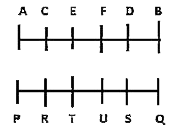Study the following information carefully and answer the given questions. Twelve persons are sitting in two parallel rows at equal distance facing each other. A, B, C, D, E and F are sitting in Row 1 facing south. P, Q, R, S, T and U are sitting in Row 2 facing north (but not necessarily in the same order).
U sits third to the right of P and one of them sits at the ends of the row. A sits at the right end of the row. Three persons sit between A and D. T sits to the immediate left of U. Two persons sit between T and Q. Q who faces B sits to the immediate right of S. C faces R. E sits to the immediate left of C.
What is the position of E with respect to B?
Third to the left
Second to the left
Second to the right
Third to the right
The correct Answer is:D
U sits third to the right of P and one of them sits at the end of the row. A sits at the right end of the row. Three persons sit between A and D. T sits to the immediate left of U. Two persons sit between T and Q. Q who faces B sits to the immediate right of S. C faces R. There will be two possibilitie i.e. case-1 and case-2.

E sits to the immediate left of C. So, Case 1 will be eliminated.
So, the final arrangement is:

Similar Questions
पांच तत्व A, B, C, D व E के E∘ क्रमशः −1.36,+0.32,+1.36,−0.42 तथा −2.2.6 है उनको बढ़ती सक्रियता के क्रम में लिखो ।
View Solutionसमान चालकता सेल में लिए गए दो विलयनों A तथा B के प्रतिरोध क्रमशः 50 ओम तथा 100 ओम है । यदि A व B के सामान आयतन मिला दिए जाये तो सामान चालकता सेल में मिश्रण का प्रतिरोध क्या होगा ?
(मोल A व B को मिलाने पर वियोजन की मात्रा में कोई परिवर्तन नहीं होता है)
View Solutionनीचे कुछ अभिक्रियाएँ दी गयी है-
(a) ACl2+B→BCl2+A
(b) B+DCl→ कोई अभिक्रिया नहीं
(c) C+2DCl→2D+CCl2
(d) C+ECl2→ कोई अभिक्रिया नहीं
(e) H2+ECl2→2HCl+E
(f) H2+FCl2→ कोई अभिक्रिया नहीं
उपरोक्त दिए तत्वों (A से F) को रासायनिक सक्रियता के घटते क्रम में व्यवस्थित करो ।
View Solutionयदि A और B दो घटनाएँ इस तरह से हों कि P(A)=13,P(B)=14,P(A∩B)=15 तो P(A/B)=
View Solutionनिम्नलिखित कथनों पर विचार करें :
कथन I : यदि A और B प्रतिदर्श समष्टि S के संगत दो घटनाएँ ऐसा है कि P(A)=0.2 और P((B)=0⋅8 तो A⋃B एक सुनिश्चित घटना है |
कथन I : यदि A और B परस्पर अपवर्ती हों तो P(A)+P(B)=1 इन कथनो में :
View Solutionयदि A तथा B दो स्वतंत्र घटनाएँ हों, तो सिद्ध करें कि P(A∪B)=1−P(A')P.(B')
View SolutionP and Q are the middle points of two chords (not diameters) AB and AC respectively of a circle with centre at a point O. The lines OP and OQ are produced to meet the circle respectively at the points R and S. T is any point on the major arc between the points R and S of the circle. If ∠BAC=32∘,∠RTS = ?
View SolutionP∗q=p2−q2
p%q=p2−q2
p$q=p2+q2
p∘q=pq+p+q
pΔq = Remainder of pq
p©q = greatest integer less than or equal to pq.
If p=11andq=7 , then the value of (p∗q)∘(p$q) is:
View Solution
